When Both Your Mind and Your Instruments Are Lying
In the early hours on the 8th of January in 2016, a cargo plane was reported missing in northern Sweden. The West Air Bombadier CRJ-200 made a single MAYDAY call at 01:30 before disappearing from radar.
A Norwegian Air Force F-16 discovered the crash site on a mountain plateau in Lapland an hour later, northwest of Lake Akkajaure about 9km from the Norwegian border.
Here’s the Norwegian F-16 view of the crash site using infrared.
The crash site consisted of a large crater with debris scattered in a 50-metre (55-yard) radius. No large pieces of the aircraft were visible.
The mountainous terrain was dangerous and the temperatures were -30°C (-22°F). The site was far enough north that the sun would not clear the horizon for months. Search and rescue teams struggled to get to the site, which was only accessible by helicopter or snow mobile. The first responders quickly confirmed that the aircraft was completely destroyed in a high energy impact. There was no chance of survival.
There was very little information to be had. The aircraft had been in the cruise at FL330 (33,000 feet) and appeared to have suddenly descended, with one newspaper reporting an estimated rate of 9,000 feet per minute. The skies were clear at the time of the accident and there was no obvious explanation as to what had gone wrong.
The following day, pieces of the smashed Digital Flight Data Recorder were collected but it was unclear if the memory unit was complete. The crash had been violent and destructive: the biggest pieces of the wreckage were only 50 cm (20 inches) in diameter.
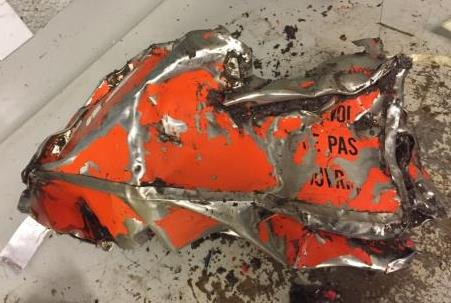
The cockpit voice recorder was found but the section holding the memory module was missing.
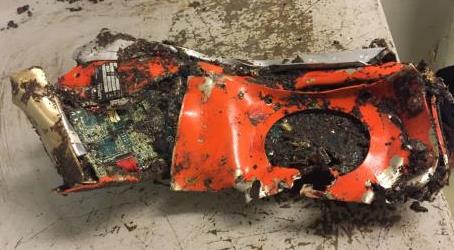
The conditions at the accident site were so poor, exploration work had to be put on hold until the ground had thawed in the summer. It was clear that the aircraft impacted the ground at high speed but why remained a mystery.
Rumours began to build: a mid-air collision with a military aircraft or possibly an unmanned aerial vehicle. The transcript from the Cockpit Voice Recorder did nothing to clarify things, as the conversation between the two pilots showed nothing but confusion and swearing.
In March, the preliminary report was released with only the most basic sequence of events from the information that they were able to recover from the data recorders.
The aural warning for autopilot disconnect sounded. Both left and right elevators moved, lowering the nose. The engine’s oil pressure dropped as the aircraft entered a descent with vertical acceleration values corresponding to -1G.
The trim was manually activated and the trim position went from -0.9° nose-up to 1.7° nose-down. An aural warning sounded for excessively steep bank angle. The maximum speed (VMO) of 315 knots was exceeded and the overspeed warning activated. The first officer made a MAYDAY call which was confirmed by ATC. The indicated airspeed exceeded 400 knots. The stabiliser trim was reactivated as the captain called ‘Mach trim’. The engine power was reduced to idle.
The last valid value on the Flight Data Recorder shows the speed increasing to 508 knots (940 km/h, 584 mph) and vertical acceleration at +3G. For comparison, this is the maximum g-force of the Space Shuttle during launch and re-entry and just below the G-force of a high-g roller coaster.
This, they could tell from the data recovered. However, the four values for the attitude of the aircraft (pitch, roll, ground speed and mag heading) did not agree. Something was very wrong and among other things, investigators began to suspect that the information on the pilots’ screens were not in synch.
No one could make sense of what had happened. Based on the cockpit recordings, the flight crew didn’t know either as they struggled to gain control of the aircraft.
23:19:22 Captain: [expletive]
23:19:29 First Officer: [expletive]
23:19:30 Captain: [expletive]
23:19:33 First Officer: Come on
23:19:35 Captain: Come on, help me, help me, help me
23:19:35 First Officer: Turn right
23:19:36 First Officer: What
23:19:37 Captain: Help me, help me
23:19:38 First Officer: Yes, I’m trying
23:19:40 First Officer: Turn left, turn left
23:19:43 First Officer: Turn left
23:19:44 First Officer: No
23:19:50 – 23:20:09: First Officer transmits the standard mayday call and repeats it several times
23:19:59 Captain: Mach trim
23:20:01 First Officer: Trim, trim a lot
23:20:06 First Officer: Turn left, turn left
23:20:14 Captain: We need to climb, we need to climb
23:20:15 First Officer: Yeah, we need to climb
23:20:16 First Officer: Turn left, turn left
23:20:17 Captain: No, continue right, continue
23:20:19 Captain: Continue right
23:20:20 First Officer: Ok
23:20:22 Captain: No, help me, help me please
23:20:23 First Officer: I don’t know, I don’t see anything
23:20:24 First Officer: I think you are the right to correct
23:20:25 Captain: Ok
23:20:26 Captain: Ok, ok, yeah
23:20:28 Captain: [expletive]
23:20:31 First Officer: [expletive]
The aircraft crashed into the ground just one minute and twenty seconds after the initial loss of altitude.
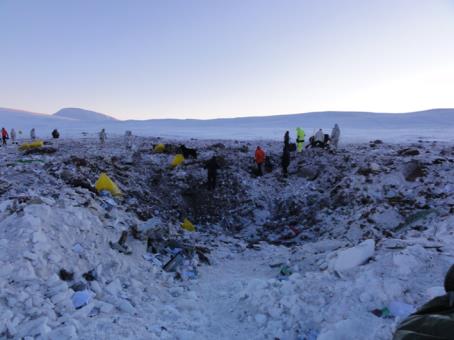
It was a long wait until investigators were able to complete a second examination of the wreckage. As the preliminary report concluded that there was a problem with the data, they needed to recover instruments from the wreckage to look for knob positions or witness marks (scratches, paint transfer or terrain damage). However, the impact of the crash melted some of ice and snow when the aircraft struck. This quickly froze over again, leaving the wreckage imprisoned in ice. The remote location meant it was impossible to transport heavy machinery to the site. The only option was to wait until the area thawed.
In June, a team were able to access the site to clean up the crash area by hand, including retrieving the mail spread across the mountainside but there was very little information released about what they found. The investigators wanted to be as thorough as possible when it came to their analysis; it wasn’t until December that the final report was released.
Accident in the arctic north of Sweden to a Canadair CRJ 200 aircraft (SE-DUX)
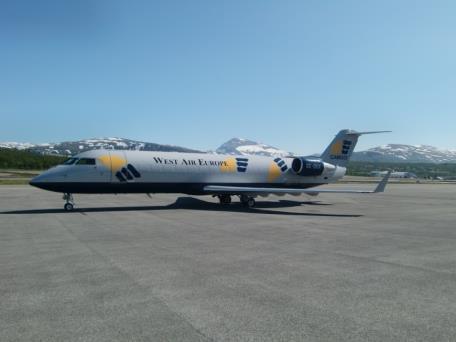
The aircraft was flying level at FL330 (33,000 feet) with an airspeed of 275 knots. The autopilot was engaged. The pilots were likely pretty relaxed. They were doing a routine approach briefing, so the cockpit lighting was probably lit to look at the maps.
That’s when the Inertial Reference Unit (IRU) malfunctioned. The IRU uses gyroscopes and accelerometers to determine an aircraft’s change in rotational attitude: that is, the IRU measures the rates of pitch, roll and yaw and reports it to the Flight Management System. The Flight Director and the Autopilot use the output from the IRU for their inertial data.
Suddenly, the IRU showed parameters that were clearly wrong when it came to pitch, roll and heading. These erroneous parameters were displayed on the left-side pilot flying displays, that is they appeared for the captain, who was also the pilot flying. Suddenly, according to the attittude indicator, the aircraft was climbing. There was nothing to see outside, not even the moon.
The captain was clearly monitoring his instruments as he almost immediately cried out in surprise at sudden pitch change showing on his display. Night blind from the cockpit lights and suffering from surprise effect, the captain was immediately at a disadvantage and probably suffered spatial disorienation as a result. The autopilot disconnected, almost certainly because of the mismatched data, and sounded an alarm, drawing the first officer’s attention to the problem.
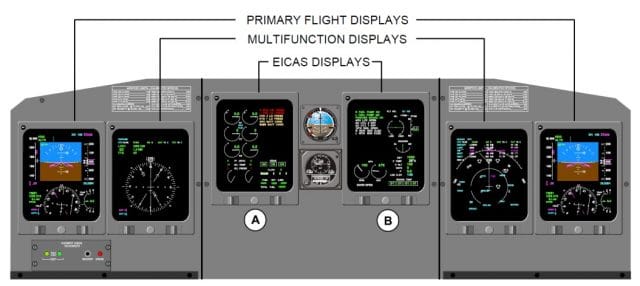
The pilot flying displays went into declutter mode as a result of the changing pitch angles. The declutter function shows only roll and pitch angle on the attitude indicator when the aircraft is in an unusual attitude.
The captain saw the pitch increase from 15° to more than 30° as the autopilot disconnected. His pilot flying display showed red chevons signalling him to pitch down in order to regain straight and level flight.
The aircraft pitched down, descending, almost certainly a correction by the captain to the high pitch angle showing on his display. He would urgently have wanted to exit the unusual attitude which he has inexplicably found himself in.
The idea of decluttering is to clear unnecessary information so that it is easier to see what the situation is. However, the declutter mode also clears indications of instruments errors. A caution had been triggered but was not displayed. Worse, the investigation found that when training for unusual attitudes, the indications comparing the two flight displays were displayed. There was no way for them to guess that the cautions had been removed from their display.
Thus, the captain had no inkling that there was a mismatch in his flying display compared to his first officer’s. The system cannnot know which pilot flying display has the correct parameters and the declutter function kept the pilots from seeing that there was a caution at all.
Alarms continued to sound in the cockpit, including an engine oil warning. The CVR also recorded thumping, probably the files and manuals hitting the roof as a result of the negative g’s. The pilots would have been lifted up from their seats and pushed against their seatbelts. The aircraft rolled to the left, which might have been the result of the first officer grabbing the controls as he lifted towards the ceiling.
The spatial disorientation would have been extreme, and might have included the feeling of being upside down (inversion illusion). The captain did not react to the physical disorientation he must have been feeling and focused on his instruments. His instruments were wrong.
The bank angle warnings sounded and then the overspeed warning. As the first officer made his mayday call, the speed continued to increase. The engine thrust was reduced to idle. Both crew were focused on working out what was wrong but they clearly did not realise that they had different perceptions of what was happening. In instrument flight, especially in extreme conditions, you must learn to disregard what your body is saying and rely on the instruments. When both your body and your instruments are lying to you, however, you don’t have a chance.
Thirteen seconds after the initial IRU failure, the crew had completely mismatched displays, with red chevrons pointing in opposite directions. Neither pilot had any idea that what he was seeing was not what the other pilot was seeing.
Both pilots exclaimed and the first officer said ‘come up’. There was no set phrasing to use at this point and there was no call that either pilot had assumed manual control. The Stab Trim Clacker sounded and another Triple Chime (master warning) which was then cut-out by two Bank Angle warnings.

The only possible clue to their state would have been the standby horizon, which was correct, but overwhelmed by audio and visual cautions and struggling under g-load and physical illusions, neither crew noticed. They almost certainly focused on their individual attitude indicators, looking for the right maneuvre to fix the unusual attitude that they were in, without a clue as to how they got into this position. Neither pilot had any reason to look for confirmation that their pilot flying display was correct.
The flight crew communications during the flight, up to the beginning of the event, indicate an open dialogue with mutual forgiveness and exchange of information. SHK therefore concludes that the lack of communication until now in the course of events was not based on any hierarchical conditions that impaired the communication. However, the silence of the crew is a clear indication of a lack of understanding of the current situation and an inability to verbally communicate to troubleshoot the abnormal situation. Variations in G-load probably also affected communication ability.
The captain was responding to the situation with careful flight control inputs as per his training but, with the erroneous display, it wasn’t fixing the problem. It was making it worse.
He called for help and the first officer responded by calling out different roll directions but it was probably not clear to the captain what the first officer meant.
Seventeen seconds in, the overspeed warning sounded. The G-load went positive and the CVR was filled with thumping sounds again, loose objects falling back down towards the cockpit floor.
The aircraft’s structural integrity was now at risk. It was flying so fast and so steep, it is unlikely that any response by the disoriented crew could have recovered it. In just twenty-four seconds after the initial failure, the altitude and speed data were so extreme that the investigators gave up on trying to analyse what was happening, other than to confirm that the crew kept transmitting distress calls and continued to try to recover the out-of-control aircraft.
It makes me feel a little bit sick just to think about it.
In one minute and twenty seconds – less time than it took you to read to this point of this article but what must have seemed like forever as they were hurtling towards the ground – the aircraft crashed into the ice.
Factors as to cause and contributing factors
The accident was caused by insufficient operational prerequisites for the management of a failure in a redundant system.Contributing factors were:
- The absence of an effective system for communication in abnormal and emergency situations.
- The flight instrument system provided insufficient guidance about malfunctions that occurred.
- The initial manoeuver that resulted in negative G-loads probably affected the pilots’ ability to manage the situation in a rational manner.
You can read the full report here: Accident in the arctic north of Sweden to a Canadair CRJ 200 aircraft (SE-DUX)
The captain was 42 years old with 3,365 flying hours. The first officer was 33 and had 3,232 hours flying time. Between them, they had plenty of experience but also just twenty-four seconds to diagnose the sudden and inexplicable situation they found themselves in during what had appeared to be a routine approach. The investigation report ends with a stack of safety recommendations, including a call for to ICAO and EASA to develop a system of initial standard calls for the handling of abnormal procedures, which might have given them a chance of discovering that they were reaction to two different events. They also firmly recommend that Pilot Flying Displays be designed to not remove pertinent cautions during unusual attitudes, a very simple fix which would have made this tragic accident a non-issue.








Scary. It is easy enough to determine what the pilots should have done. But I am sitting behind a desk, reading Sylvia’s report.
To be quite honest: In my considered opinion more than 70% of all pilots, if confronted with exactly the same set of circumstances, would have crashed. Of the 30% that in my guesstimate may survive, the majority would have had to thank their survival to their lucky star. And I do not exclude myself, this sounds like a situation that in the blink of an eye became non-survivable. Unless the crew had by chance happened to notice that the standby horizon told them a different story from the main instruments, and acted on it instantly, they were doomed. No visual cues outside would have been a major contributing factor.
Poor guys, may they rest in peace.
While I’m not a pilot, I do investigate fatal accidents for a living and am an engineer – I think your estimate of 70% is rather low.
Does an airplane like this not have any ‘steam gauges’ surrounding the glass cockpit for backup? Just an artificial horizon and compass (and the training to use them) would have made a HUGE difference in this situation.
there is usually a set of basic standby instruments, sometimes packed into a single, autonomous instrument (with its own data source and power supply). but it is safe to assume that at least a magnetic compass and sone sort of attitude indicator will be always there.
greetings from a pilot and non-aviation crash investigator ;)
Greetings! And thanks. :)
In this case, there were three instruments that showed the attitude of the aircraft and only one of them was wrong. But you have to be aware that there’s a reason to look at the other ones. If there’d been a clue that the left-hand guage was wrong, it would have been easy to solve. But without that hint and with only twenty-four seconds elapsed, it’s very difficult.
All comments are valid, my estimate of “70%” was plucked out of thin air, based on how I think some pilots I flew with would have reacted, as well as my own experience in a situation where we suddenly were confronted with an accumulation of inputs: instrument failure (IAS), radio transmissions interfering with cockpit indications, an unexpected thunderstorm, icing that, albeit light, still caused internal engine icing and a near flame-out. We had an experienced engineer on board who could not figure it all out either and the combination of factors was not something we had been trained to cope with.
So when I try to put myself in the place of the unfortunate West Air crew I can understand how come, in the very first moments of realising that “something was not right”, they did not draw the correct conclusion.
I base my “30%” (survival) on the very rigorous training major airlines give their crew, especially when it comes to falling back on constantly rehearsed and enforced communication and emergency procedures between cockpit crew members and their very strict adherence to them.
This might, just might have led to them comparing their instruments and realising that one out of two was incorrect. But the combination of the autopilot disconnecting, various and conflicting attitude inputs, aural and visual warnings, varying g-forces (although +3 g does not really seem that extreme, in aerobatics we sometimes pulled + 4.5 and many more experienced pilots a lot more but it must have felt as such under the circumstances), the onset of vertigo, it all would have interfered with corrective action. The captain, so it seems, in an attempt to fight it, actually made the situation worse.
Things spiraled out of control so rapidly that a crash became inevitable in a very short time.
Man, as a pilot with almost 3000 hrs myself, I’m fairly confident I would not have survived either. Correcting from unusual attitudes (as we all know) demands an immediate and well rehearsed corrective response based on what your indications are telling you. It would have been task saturation in that moment, and I think very few pilots would have had the ability to step back and compare instrument indications in time to prevent an unrecoverable situation. Very scary.
I believe the captain followed his flight director indication all the way to the ground. The copilot was seeing almost a mirror image which would be very hard to rationalize. Although high negative G should have been a strong indicator that they were applying the wrong inputs.
Many years ago I had the privilege of working with NASA test pilots in a simulation that included failures, some of which were unrecoverable. One of them asked me how he was expected to fly without the flight director working. He did just fine without it and others seemingly could have flown the fixed simulator by the seat of their pants. Just an observation that even the best can become reliant on following the needles.
On the other hand airspeed, altitude and turn & bank were hammered into me as the ONLY unusual attitude recovery instruments. If the airspeed is climbing and the altitude is declining – pull up. And in the process center the ball and turn indicator. Adjust power and speed brakes to avoid an over speed.
Not a critique of these two, but a reminder how simple it can be to regain situational awareness when the magic boxes stop working.
Or am I still in the Dark Ages? I admit I flew the last L-N range (for fun) just before it was shut down.
I agree with Chad. First of all, we must realise that NASA test pilots are a “breed apart”. They have been selected from the best of the very best. They would – most of them – have had experience in high performance military jets. And they would have attended training at a test pilots’ training facility. They also would have been used to high “G” loads, both during aerobatics and during training.
A relatively small cargo airline would not have been able to afford all the training facilities that NASA have access to. They were decent, qualified and probably competent line pilots.
During a routine mission, with no pre-warning that anything was about to go wrong, the West Air crew were suddenly confronted with a rapidly changing set of visual, aural and other cues that were conflicting.
“Needle-ball-airspeed”:: yes I know the value of this corrective action, but with changing g-forces and an instant requirement to ignore the flight director in order to go “basic”, seat-of-the-pants flying becomes virtually impossible..
The “basic T” is replaced with state-of-the-art screens, but they are designed more with a philosophy in mind that guides a pilot through complex sets of situations by presenting data electronically, via computers.
Under the circumstances the pilots had a very limited amount of time to determine what was the cause of the problem. Training in modern aircraft with glass cockpits no longer puts emphasis on “needle-ball-airspeed”. And pulling up from a high g situation could also have pulled the aircraft apart.
The increasing sophistication of flight instruments has enhanced the capability of aircraft to fly and, most important, to make an approach and landing, under circumstances that even Doolittle would have found challenging, and lesser pilots would not have been able to manage.
But with ever increasing capability also comes the need to adapt and implement new procedures and training. There is only so much time operators can afford to put into training of their crews.
And I also flew a four-course range before it was shut down., just for the heck of it. It was in Marrakesh, Morocco. Probably around 1980.
I survived 22.000 hours of flying. I cannot claim with certainty that I would have survived the situation the West Air crew found themselves in.
I hope I did not imply that I would have survived a similar event. I think my training would have made me revert to the basics. But who knows?
But I do see a trend that pilots who get in trouble are apparently not trained to use the old fashioned stand by instruments to recover. Air France comes to mind, and I seem to recall others besides this one.
Perhaps it is time for a training push on the use of airspeed, altitude and turn & bank for recovery?
Opp’s – they were A-N ranges! I flew it in Alaska in the late 60’s, early 70’s.
Remain calm has kept myself and other crew members alive in 37 years of flying High Performance Jets. One of them being family to this aircraft. I’ve flown the CL-600 / CL-601 over two thousand hours. Which is build buy the same company. CRJ-200 is very much like the Challenger 600 / 601 . For me to say I could’ve done better or worse in this situation is something I can’t say. I’m sure they never gave up.
Having experienced spatial disorientation before at night with an unusual attitude of 90 degree bank and -25 in pitch I can tell you I would be dead right now if my primary attitude reference system was providing false indications. Trust your instruments is all I was thinking as my body was telling me something else.
Yes “trust your instruments” must be done immediately as an act of almost “blind faith”…. and it supremely uncomfortable and difficult but necessary to survive. “There but for the grace of God go I”.
Sorry. Does not seem that difficult. We trained for events at my airline frequently. If there is a disagreement between the capt & F/O instruments, you determine which one agrees with the stand by horizon and fly that system.
I would remove all the glass cockpit junk & put the flight instruments back in. Train pilots to use them. It won’t solve everything, but you won’t have crashes like this either. Or, an airbus crew discussing what to enter into the computer as the airplane was headed for the drink in a stall. And on, and on, and on.
Basic Attitude Instrument Flying!
I say this not to second guess the pilots, but to encourage all those who fly to return to the basics for a review every now and then during your recurrent training!
The declutter function of the PFD is the key contributor to this crash, in my opinion. The amber comparator monitors are removed as part of this function during unusual attitudes, even if caused by an erroneous unusual attitude indication caused by a malfunctioning source (IRU malfunction–see 2.3.1 in the original report and also SAFETY RECOMMENDATIONS for EASA in 4.). If the instrumentation is designed to “declutter” to reduce confusion in a recovery, this time, it increased confusion since none of the pilots were able to discern which attitude indicator was trustworthy. The amber monitor may have alerted the pilot flying to reference the standby attitude indicator.
I agree. And especially as this did not show the same in the sim, so the pilot’s had no reason to believe there could ever be a miscompare without it being displayed.
Oh my. Just read this. I’m not flying CRJs (yet), but do have more than 3000 hours flying military glass cockpit aircraft.
There is a definite need for standardized cockpit verbology, especially in emergency situations. Simple things such as “nose up” vs. “climb” can have vastly different meanings that are easily understood in a low stress environment. A high-stress environment can change that drastically.
Another item not necessarily of relevance, but of interest: The report says the standby attitude indicator was providing correct data. Did this particular -200 have analog backup instruments, or digital? I’ve seen pictures of both variants in -200 cockpit photos. The bird I fly has 4 (tiny) mechanical back up instruments. Having something independent and “real” could make all the difference in a cross-check…sometimes a screen is just a screen.
I’m sorry this didn’t go through immediately, I thought I’d approved it and apparently didn’t. If you post again, it’ll automatically go through!
Good question regarding the standby and I think you are right about the psychological aspect of it.
Great article. Sad, but so much to learn.
First, as mentioned above, take a second and compare with the standby. Second, communicate to make sure we are seeing the same thing. Third, practice practice practice.
Thanks for sharing – scary but an eye-opener.
As a private pilot with no instrument rating I have never flown except under VFR. However, I would have thought that at the first hint when flying straight and level, that there has been a sudden change in attitude or speed that wasn’t confirmed by the seat of one’s pants, one would immediately look for confirmation from basic instruments and what about GPS? Surely a GPS would give a reliable and separate indication of height, speed attitude and heading. I use it in my aircraft on every flight as a rough independent confirmation of instrument accuracy